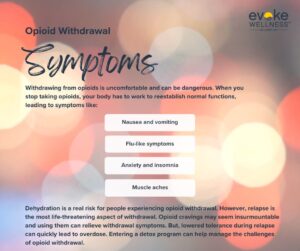Opioid medications all have side effects. Abusing opioids by taking more than directed, combining them with other substances, or using illicit opioid drugs can increase these side effects. Tramadol is an opioid commonly used for acute, short-term pain. Learning about tramadol’s side effects can help you know how long they last and if you should see a doctor.
Tramadol and all opioids are addictive. If you or a loved one need opioid addiction rehab, Evoke Wellness in Ohio can help. Through evidence-based and holistic treatment, we help patients overcome addiction and enter long-term recovery. Call 866.430.9267 to get started.
When Opioids Are Prescribed
Some opioid medications are prescribed for chronic pain management, while others are used for acute, short-term pain relief. Tramadol is one of the most commonly prescribed opioids for acute pain due to its effectiveness in reducing moderate to severe pain levels. However, it’s important to note that all opioid medications have potential side effects and can be addictive if not used as directed.
Long-term use of tramadol is not common. It is typically prescribed for short-term pain relief, such as after a surgery or injury. However, if you do require long-term opioid use for chronic pain management, it’s important to monitor your usage closely and consult with your doctor regularly. This can help reduce the risk of developing an addiction to tramadol or other opioids.
Side Effects of Tramadol
Opioid drugs interact with opioid receptors throughout the body to reduce pain. They slow down the function of many bodily processes, including breathing and digestion. Individuals who use opioids often cite constipation, nausea, and vomiting as some of their most prominent side effects. Other common side effects of tramadol may include:
- Drowsiness and dizziness
- Headaches
- Dry mouth
- Sweating or flushing
- Difficulty sleeping
Side effects of tramadol often last for a few days to about a week after starting the medication. As your body adjusts, you will likely experience fewer or less intense side effects. However, if you stop taking tramadol suddenly, you’ll likely experience withdrawal symptoms.
Opioid Withdrawal Symptoms
Withdrawing from opioids is uncomfortable and can be dangerous. When you stop taking opioids, your body has to work to reestablish normal functions, leading to symptoms like:
- Nausea and vomiting
- Flu-like symptoms
- Anxiety and insomnia
- Muscle aches
Dehydration is a real risk for people experiencing opioid withdrawal. However, relapse is the most life-threatening aspect of withdrawal. Opioid cravings may seem insurmountable and using them can relieve withdrawal symptoms. But, lowered tolerance during relapse can quickly lead to overdose. Entering a detox program can help manage the challenges of opioid withdrawal.

Who Shouldn’t Use Tramadol?
Some people may experience tramadol side effects more severely than others. Additionally, people with specific health conditions may be at a higher risk of experiencing severe or dangerous side effects. It’s important to discuss your medical history with your doctor before starting tramadol or other opioids. Your doctor may not prescribe tramadol if you have:
- Breathing problems like asthma or COPD
- Liver disease
- Kidney disease
- A history of brain damage
Addiction and mental health disorders may also affect your likelihood of being prescribed tramadol. It’s important to be honest with your doctor about any past or current substance use, as well as any mental health concerns you may have. They may recommend a dual diagnosis treatment program if you need help breaking the cycle of addiction.
Call Evoke Wellness in Ohio for Addiction Treatment
If you or a loved one are struggling with opioid addiction, it’s important to seek professional help. Opioid addiction is a chronic disease that requires comprehensive treatment. At Evoke Wellness in Hillard, Ohio, we offer evidence-based and personalized treatment programs for opioid addiction. Call 866.430.9267 or contact us online to get started.



